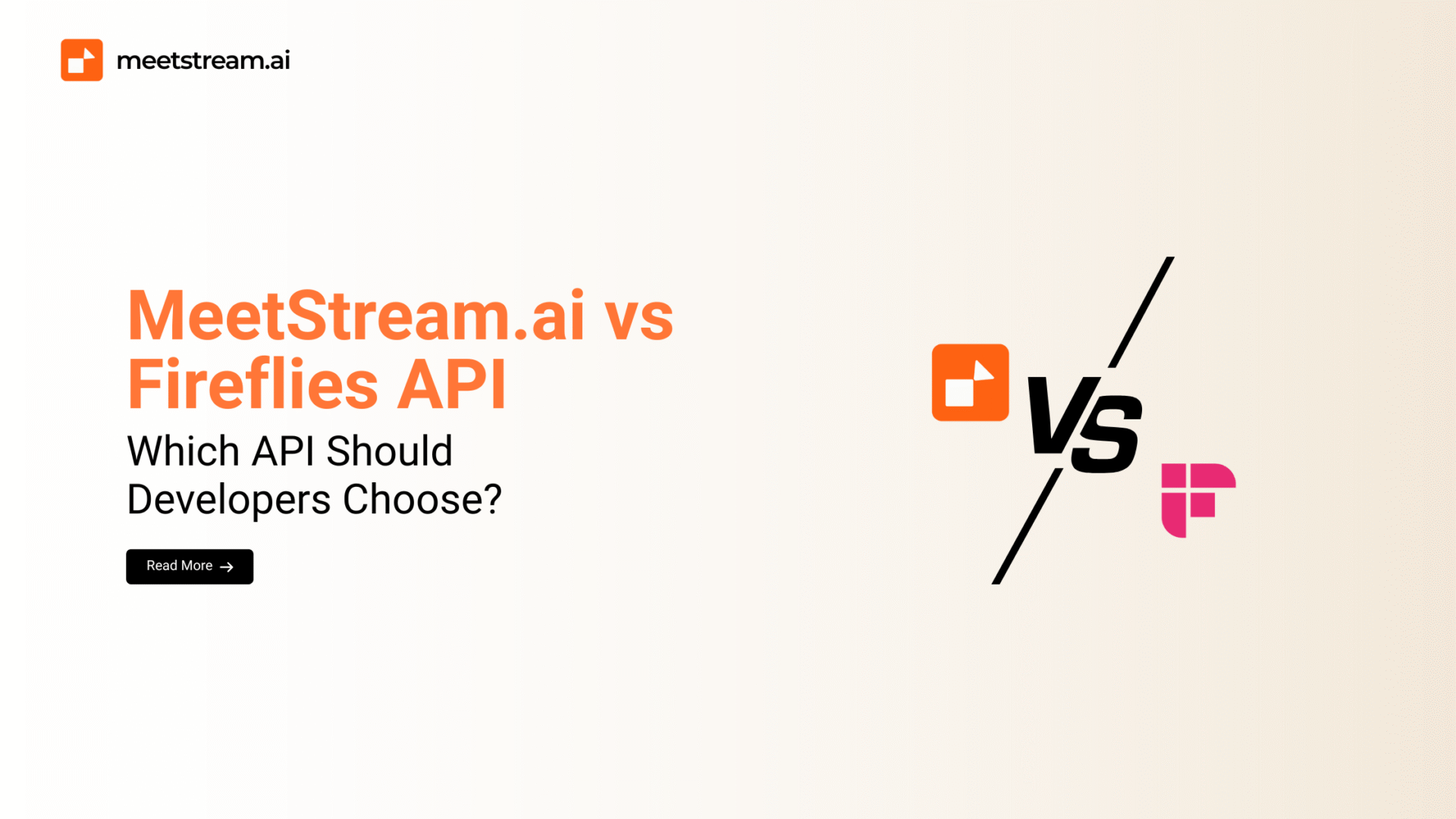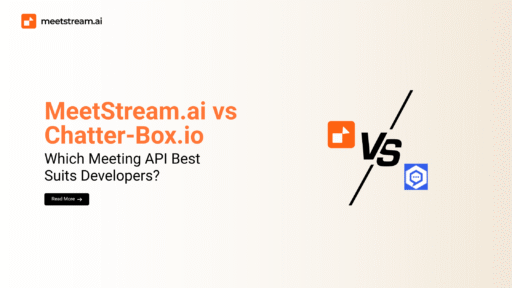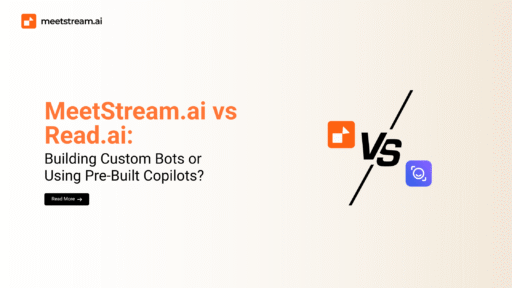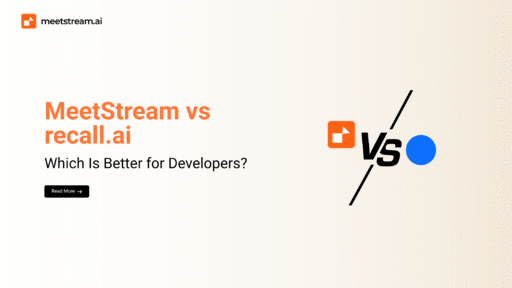The demand for meeting automation and AI-powered insights into conversations is growing rapidly. Teams are no longer satisfied with just recording or transcribing calls; they want smarter systems that can capture context, streamline workflows, and drive productivity in real time.
As someone who has worked hands-on with developer-focused meeting APIs, I’ve seen how the right platform can either become a growth engine or a limiting factor for your product.
When evaluating options, two names stand out: MeetStream.ai and Fireflies API. Both bring strong capabilities, but their focus and approach are very different.
MeetStream.ai is built as an API-first infrastructure for creating intelligent, customizable meeting bots, whereas the Fireflies API focuses on providing a powerful transcription and analysis service.
In this guide, I’ll break down their strengths, share where each one fits best, and explain why the choice depends heavily on whether you want real-time, developer-controlled meeting automation or plug-and-play transcription and insights.
What does MeetStream.ai do?
From my experience, MeetStream.ai feels like a true developer’s toolkit. It doesn’t just give you transcription; it hands you the building blocks to design bots that actively join meetings, capture audio and video streams, and perform live actions.
Key capabilities include:
- Joining meetings as a live participant.
- Real-time streaming of audio and video for context-rich applications.
- Speaker-labeled transcription for accurate, in-meeting visibility.
- Deep integrations with CRMs, project management tools, and internal systems.
This flexibility lets you create unique meeting experiences.
For example, I tested a bot that could coach sales reps during calls, automatically highlight deal risks, and push structured notes into Salesforce—all powered by MeetStream.ai’s infrastructure.
That kind of control is rare and game-changing for enterprise or SaaS products.
What does Fireflies API do?
Fireflies API, on the other hand, is purpose-built around transcription and meeting analysis. It uses a GraphQL API and offers a wide set of NLP-powered features, such as:
- Transcription with speaker labels.
- Summaries that capture key points.
- Sentiment analysis and keyword extraction.
- Topic categorization and follow-up item detection.
- File uploads for recorded meetings or podcasts.
- Real-time transcription through WebSocket events.
When I tried Fireflies, it worked best for post-meeting analysis. For example, uploading a recorded call instantly gave me a clean transcript, action items, and a digestible summary—without needing to code a custom NLP pipeline.
It’s a strong option for teams that want ready-to-use insights rather than building bots that shape conversations live.
Feature Comparison of MeetStream and Fireflies API
1. Flexibility & Customization
If your goal is deep customization, MeetStream.ai has the clear edge. It lets developers design bespoke meeting bots, dashboards, and compliance pipelines that match exact business logic.
I’ve seen this firsthand when building a customer support bot that automatically flagged priority tickets during calls. The control was precise: I could decide what data to capture, how to store it, and how to feed it into our internal systems.
Fireflies API is strong in transcription and NLP, but is not built for in-meeting automation. You can integrate its insights into workflows, but you won’t be able to build bots that actively respond or adapt mid-meeting.
It’s better suited for post-call intelligence, where summaries, sentiment, and action items are enough.
2. Meeting Access & Deployment Model
MeetStream.ai bots can join live meetings, stream audio/video, and act as real participants.
This means your apps can trigger real-time actions—for example, surfacing a client’s history when a keyword is mentioned, or nudging sales reps when a critical step is skipped.
Fireflies API mostly works with uploaded recordings or post-meeting transcripts. While it does support live transcription via WebSocket, the scope is limited to captioning and monitoring rather than complex participation.
In practice, it’s excellent for creating searchable records or generating summaries, but less for dynamic in-meeting intelligence.
3. Transcription & NLP Features
Both platforms deliver accurate transcripts, but their strengths differ.
MeetStream.ai: Provides real-time, speaker-labeled transcripts designed to power live applications.
Think of an assistant that shows captions during meetings or instantly highlights decision points.
Its strength lies in low-latency data streaming, leaving developers free to build custom NLP logic on top.
Fireflies API: Goes broader with out-of-the-box NLP. Beyond transcription, it extracts topics, detects sentiment, identifies deadlines, and auto-generates summaries.
This is perfect if you don’t want to build NLP from scratch. When I tested it, the “action item” detection was particularly useful for sales calls.
4. Integrations & Ecosystem
MeetStream.ai is API-first and integration-friendly. It connects with CRMs, calendars, and thousands of tools through no-code platforms like Pipedream.
In one workflow I set up, meeting notes flowed directly into Salesforce, while flagged risks automatically created Jira tasks.
Fireflies API also integrates well, but its focus is on distributing transcription and insights into systems like Slack, Google Drive, or CRMs.
If you want raw meeting data transformed and sent downstream, it’s a strong fit. But for real-time orchestration across systems, MeetStream.ai offers more developer control.
5. Real-Time Capabilities
Here’s where the difference becomes obvious.
MeetStream.ai: Built for adaptive real-time bots. You can design a bot that listens for dissatisfaction signals and suggests live interventions, or one that tracks agendas and gently steers meetings back on track.
It doesn’t just transcribe—it acts in the moment.
Fireflies API: Supports live transcription but focuses on streaming transcripts only.
It works well for captions or dashboards that update as words are spoken, but lacks the infrastructure for bots to react within the meeting.
Security & Compliance
Both take security seriously, but they approach it differently.
MeetStream.ai: Gives developers granular control to architect compliant data flows. You decide how data is stored, processed, and encrypted—ideal for enterprises needing SOC2, HIPAA, or GDPR compliance in very specific workflows.
Fireflies API: Provides pre-certified compliance with SOC2 Type II, HIPAA, GDPR, and BAAs. It’s ready-made for industries like healthcare or finance, where compliance must be guaranteed from day one.
Pricing of MeetStream and Fireflies
Pricing is a deciding factor for most teams.
MeetStream.ai: Follows a usage-based model, charging for API calls or minutes processed. This scales well for enterprises and SaaS platforms.
While you may invest more upfront in developer time, the payoff is a customizable system that becomes a long-term asset.
I’ve found this model delivers higher ROI once your workflows are running smoothly.
Fireflies API: Uses subscription pricing, typically $0–$29/user/month with enterprise tiers for advanced features.
The value is in its immediacy—you can start generating transcripts and insights the same day, with little setup.
It’s cost-predictable and ideal for smaller teams or use cases where time-to-market is critical.
Pros & Cons of MeetStream.ai and Fireflies API
MeetStream.ai
Pros:
- Unmatched customization and developer control.
- Bots can join and act in real time.
- Enterprise scalability with flexible API-first design.
- Easy deep integration across business systems.
Cons:
- Requires more developer resources.
- Steeper learning curve compared to plug-and-play APIs.
- Longer setup before the value is fully realized.
Fireflies API
Pros:
- Strong out-of-the-box transcription & NLP insights.
- Certified for SOC2, HIPAA, and GDPR with enterprise-grade security.
- Faster go-to-market for note-taking and analysis.
- Simple for non-developers to use.
- Predictable, subscription-based pricing.
Cons:
- Limited in real-time participation.
- Less scope for custom bot behavior.
- Primarily designed for post-meeting analysis.
- Restricted to Fireflies’ NLP models and feature set.
Conclusion
Choosing between MeetStream.ai and Fireflies API depends on your goals and resources.
If your team needs fast transcription, summaries, and NLP insights without heavy coding, Fireflies API delivers excellent value.
It’s best for teams that want to automate note-taking, analyze conversations, and enrich CRMs quickly.
But if you’re building a SaaS product, enterprise workflow, or custom meeting automation tool, MeetStream.ai is the stronger choice.
It gives developers granular control, real-time bot participation, and API-first flexibility that can turn meeting intelligence into a strategic advantage.
From my perspective, Fireflies API is great when you want something that “just works.” But if you want to own the meeting experience, craft adaptive bots, or build compliance-driven pipelines, MeetStream.ai is the platform I’d trust every time.





